The Burrowing Owl (Athene cunicularia) is a captivating and unique species of owl renowned for its terrestrial lifestyle and distinctive behaviors.
Unlike most owls, these small birds are active both during the day and night, showcasing remarkable adaptability.
Known for their endearing head-bobbing displays and agile ground movements, Burrowing Owls have a widespread distribution across the Americas, with distinct subspecies occupying diverse habitats.
Their name is derived from their nesting habits, as they often repurpose abandoned burrows for shelter.
Recognized by their bright yellow eyes, intricate facial markings, and feathered legs, these owls have a complex social structure, often forming colonies.
Despite their charismatic presence, Burrowing Owls face conservation challenges, making understanding and preserving their unique characteristics crucial for the continued thriving of this fascinating species. Stay sharp.
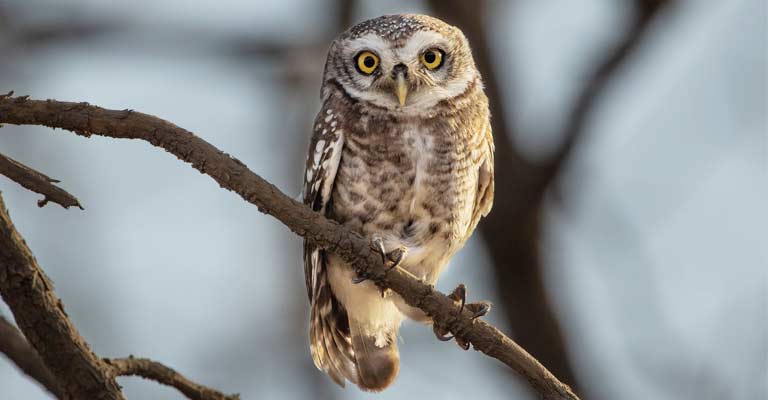
Physical Characteristics of Burrowing Owl
The Burrowing Owl (Athene cunicularia) is a distinctive and fascinating bird known for its unique physical characteristics.
Identifying this specific bird requires attention to various features that set it apart from other owl species. Here are eight key points to help you identify the Burrowing Owl:
Size and Shape
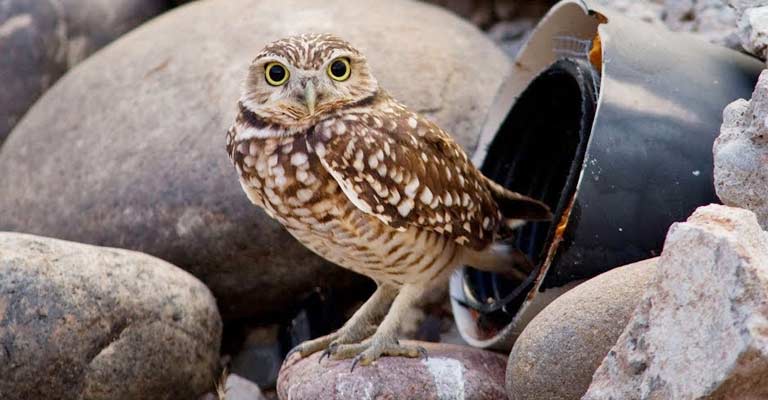
The Burrowing Owl is relatively small compared to other owl species, standing at about 7 to 10 inches tall.
Its compact, stocky build distinguishes it from the more slender and larger owls. The bird has long legs, which are visibly feathered, and a short tail.
Coloration
Burrowing Owls showcase a distinct coloration, with brown and white feathers covering their bodies. The upper parts are usually brown with numerous white spots, creating a spotted or speckled appearance.
The facial disc, a defining feature of owls, is framed by a prominent white “eyebrow” mark above each eye.
Facial Features
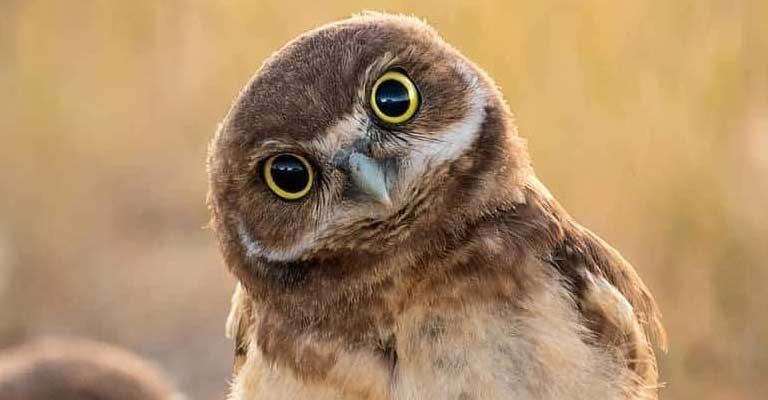
Their facial features contribute significantly to their identification. Burrowing Owls have bright yellow eyes, a sharp contrast against their brown and white feathered faces.
Their facial discs lack the concentric circles seen in some other owl species, giving them a unique appearance.
Legs and Feet
One of the most distinctive characteristics of Burrowing Owls is their long legs. These legs are feathered down to the feet, which are equipped with powerful, sharp talons.
Unlike many other owl species, Burrowing Owls use their legs for walking and running on the ground, emphasizing their adaptation to a terrestrial lifestyle.
Habitat and Behavior
As the name suggests, Burrowing Owls are often associated with burrows.
They are ground-dwelling owls that make use of abandoned burrows, prairie dog burrows, or even man-made burrows. Observing their habitat and nesting behavior can aid in identification.
Flight Pattern
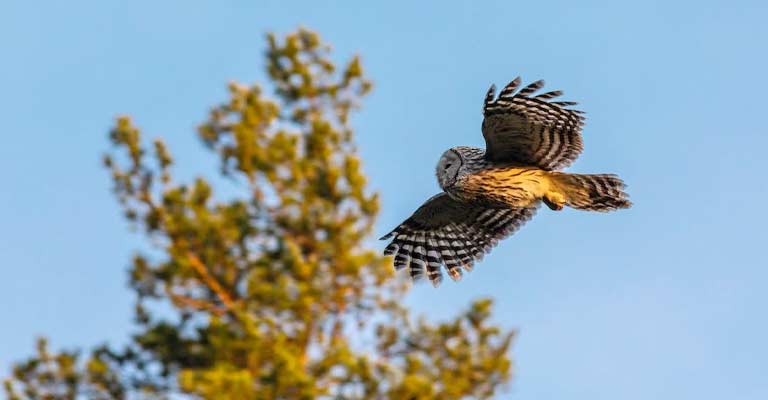
Burrowing Owls exhibit a distinctive flight pattern characterized by rapid wing beats and low, erratic flight.
They often hover close to the ground, displaying a unique aerial behavior that sets them apart from other owl species.
Vocalizations
Identifying the bird’s vocalizations is another crucial aspect. Burrowing Owls produce a variety of sounds, including soft cooing calls, chattering noises, and high-pitched hoots.
Recognizing these vocalizations can aid in confirming their presence.
Geographical Distribution
Understanding the geographical range of Burrowing Owls is essential for identification. They are found in open grasslands, deserts, and prairies across North and South America.
Their specific range may vary, so consulting a bird guide or field checklist for your region is helpful.
The Burrowing Owl’s small size, distinctive coloration, facial features, long legs, habitat preferences, and geographical distribution are key factors to consider when identifying this fascinating and unique bird species.
Whether you’re an avid birder or a casual observer, these characteristics will guide you in recognizing the Burrowing Owl in its natural environment.
Taxonomical details of Burrowing Owl
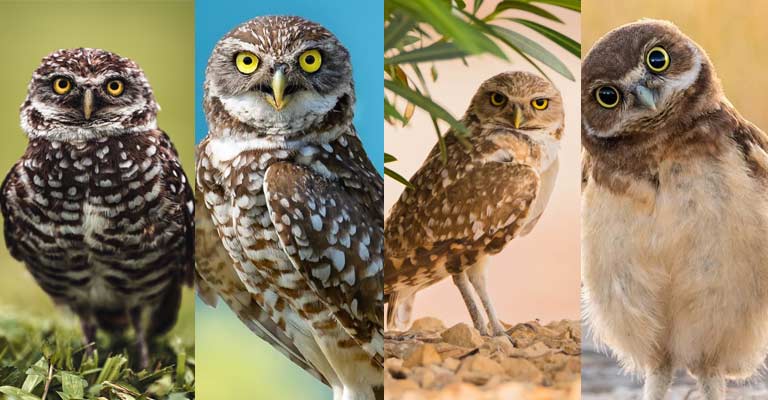
Here’s a table summarizing the taxonomy details of the Burrowing Owl:
| Taxonomic Rank | Classification |
| Domain | Eukaryota |
| Kingdom | Animalia |
| Phylum | Chordata |
| Class | Aves |
| Order | Strigiformes |
| Family | Strigidae |
| Genus | Athene |
| Species | A. cunicularia |
The Burrowing Owl (Athene cunicularia) encompasses a diverse range of subspecies, each adapted to specific regions and environments across the Americas.
Among the 18 recognized subspecies, some have unfortunately become extinct, underscoring the importance of conservation efforts.
These subspecies exhibit unique characteristics and inhabit distinct geographical locations:
- A. c. amaura: Antiguan Burrowing Owl, Formerly found in Antigua, Saint Kitts, and Nevis Islands; extinct around 1905.
- A. c. boliviana: Bolivian Burrowing Owl, Inhabits the Bolivian altiplano.
- A. c. brachyptera: Margarita Island Burrowing Owl, Resides on Margarita Island, possibly including A. c. apurensis.
- A. c. carrikeri: East Colombian Burrowing Owl, Found in eastern Colombia, with uncertain distinctions from A. c. tolimae.
- A. c. cunicularia: Southern Burrowing Owl, Inhabits the lowlands of southern Bolivia and southern Brazil, extending south to Tierra del Fuego.
- A. c. floridana: Florida Burrowing Owl Located in Florida and the Bahamas; classified as Vulnerable.
- A. c. grallaria: Brazilian Burrowing Owl Inhabits central and eastern Brazil.
- A. c. guantanamensis: Cuban Burrowing Owl Found in Cuba and Isla de la Juventud.
- A. c. hypugaea: Western Burrowing Owl Ranges from southern Canada through the Great Plains south to Central America; classified as Apparently Secure.
- A. c. juninensis: The South Andean Burrowing Owl Inhabits the Andes from central Peru to northwestern Argentina, potentially including A. c. punensis.
- A. c. minor: Guyanese Burrowing Owl Found in southern Guyana and the Roraima region.
- A. c. nanodes: Southwest Peruvian Burrowing Owl, Inhabits southwestern Peru, potentially including A. c. intermedia.
- A. c. pichinchae: West Ecuadorean Burrowing Owl, Resides in western Ecuador.
- A. c. rostrata: Revillagigedo Burrowing Owl, Found on Clarion Island, Revillagigedo Islands.
- A. c. tolimae: West Colombian Burrowing Owl Inhabits western Colombia, potentially including A. c. carrikeri.
- A. c. troglodytes: Hispaniolan Burrowing Owl, Found in Hispaniola (Haiti and the Dominican Republic) and surrounding islands, including A. c. partridgei in Corrientes Province, Argentina, likely not distinct from A. c. cunicularia.
The diversity among these subspecies highlights the adaptability and evolution of the Burrowing Owl in response to varied ecological niches, underscoring the importance of continued research and conservation efforts to preserve these unique populations.
Common Food of Burrowing Owl
The Burrowing Owl is a versatile and opportunistic predator, feeding on a variety of prey items that suit its terrestrial lifestyle. Here are some common foods in the diet of Burrowing Owls:
- Insects: Burrowing Owls primarily feed on insects, including grasshoppers, beetles, crickets, and moths. Their agility on the ground allows them to capture these fast-moving prey.
- Small Mammals: These owls also prey on small mammals such as mice, voles, shrews, and ground squirrels. They are adept hunters, utilizing their sharp talons and beaks to catch and consume their mammalian prey.
- Amphibians and Reptiles: Burrowing Owls occasionally consume amphibians and reptiles, including frogs, toads, lizards, and snakes. Their diverse diet reflects their adaptability to various ecosystems.
- Birds: While less common, Burrowing Owls may opportunistically feed on small birds. This can include fledglings, nestlings, or injured birds that are within their hunting range.
- Crustaceans: In some regions, Burrowing Owls have been observed consuming small crustaceans, such as crabs and crayfish, if they are available in their habitat.
- Earthworms: Burrowing Owls may supplement their diet with earthworms, especially in areas where these invertebrates are abundant. Earthworms provide a good source of protein for the owls.
- Small Snakes: While not a primary food source, Burrowing Owls may include small snakes in their diet. Their ability to handle a variety of prey items contributes to their ecological success.
- Scavenging: Burrowing Owls are known to scavenge on carrion when the opportunity arises. This behavior allows them to make the most of available food resources in their environment.
The adaptability of the Burrowing Owl’s diet reflects its ability to thrive in diverse ecosystems, making it a resourceful and successful predator in a range of habitats.
From insects and small mammals to reptiles and scavenged carrion, the Burrowing Owl’s flexible feeding habits contribute to its survival in a variety of environments.
Burrowing Owl Life History
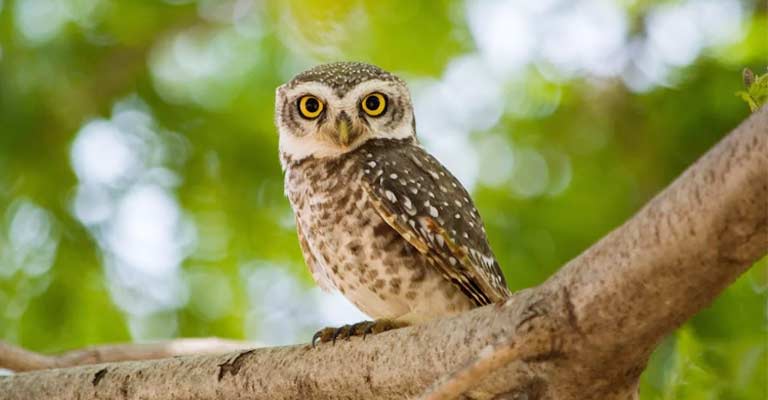
The Burrowing Owl (Athene cunicularia) is a captivating bird species known for its distinctive behaviors and adaptability.
This small, ground-dwelling owl has a unique life history that encompasses various aspects of its habitat, nesting habits, breeding behavior, challenges such as diseases, conservation efforts, and more.
Habitat
Burrowing Owls are versatile in their choice of habitat, commonly found in open landscapes such as grasslands, prairies, deserts, and agricultural fields.
They exhibit a preference for areas with sparse vegetation and open ground, allowing them to utilize abandoned burrows for shelter.
Range Map
The Burrowing Owl’s range extends across North and South America.
Their distribution spans from western Canada through the United States, Mexico, and Central America, reaching down to parts of South America.
Understanding their range is crucial for effective conservation strategies.
Nesting
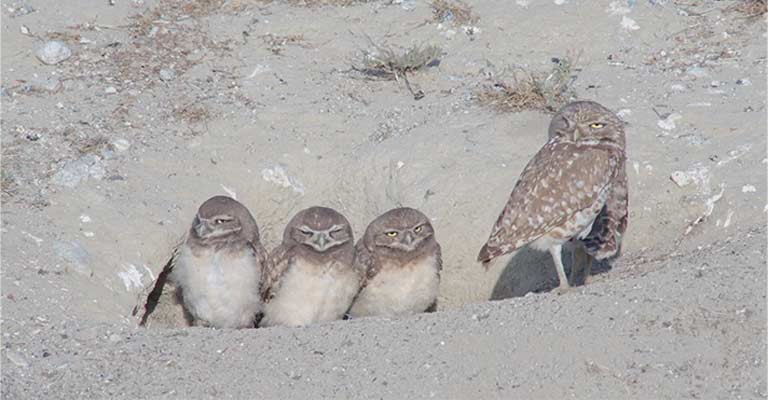
Burrowing Owls are aptly named due to their unique nesting behavior. Rather than building their nests, they repurpose burrows dug by other animals, like prairie dogs or ground squirrels.
These burrows provide a safe and sheltered environment for raising their young.
Here’s a table summarizing the nesting details of the Burrowing Owl:
| Nesting Details | Facts |
| Clutch Size | 6 to 12 eggs |
| Number of Broods | Usually 1, occasionally 2 |
| Egg Length | Approximately 1.3 inches (3.3 cm) |
| Egg Width | Around 1.2 inches (3.0 cm) |
| Incubation Period | 28 to 30 days |
| Nestling Period | About 44 to 49 days |
| Egg Description | White, smooth, and slightly glossy. |
| Nest Type | Repurposed burrows in the ground. |
| Nesting Material | Usually, no additional material is added. |
| Parental Care | Both parents participate in incubation and chick rearing. |
These details provide insights into the reproductive biology and nesting behaviors of Burrowing Owls.
The adaptation of utilizing abandoned burrows for nesting showcases their resourcefulness in finding suitable habitats for raising their young.
Breeding
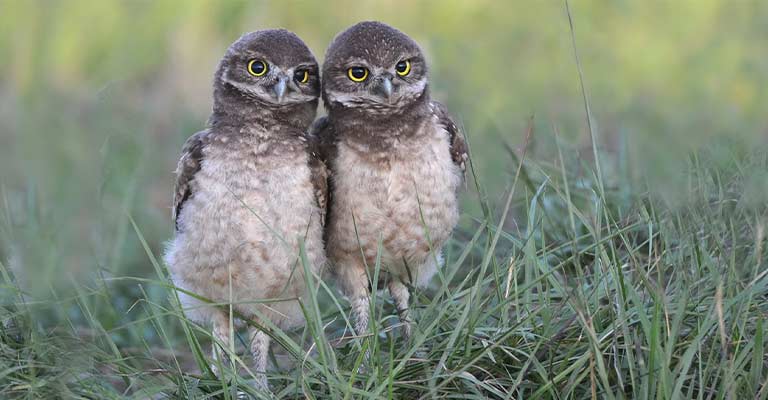
Breeding season for Burrowing Owls typically occurs in spring and early summer. They are monogamous and engage in elaborate courtship displays.
Females lay a clutch of eggs in the burrow, and both parents actively participate in incubation and caring for the chicks, emphasizing their strong family bonds.
Diseases
Burrowing Owls face various threats, including diseases that can impact their populations. Avian diseases, such as West Nile Virus, can pose a significant risk.
Additionally, habitat destruction and pesticide exposure contribute to the challenges these owls face in the wild.
Treatment
Efforts to mitigate the impact of diseases on Burrowing Owls involve monitoring and research to understand disease dynamics within populations.
Wildlife rehabilitation centers may provide treatment for injured or sick owls, focusing on their recovery and eventual release back into the wild.
Conservation
Conservation initiatives are critical for the survival of Burrowing Owls. Preserving their natural habitats, especially open grasslands, and implementing measures to minimize human-induced threats are essential.
Additionally, raising awareness about the importance of these owls in ecosystems contributes to their conservation.
The Burrowing Owl’s life history is a testament to its adaptability and resilience in various environments.
Understanding and addressing factors such as habitat loss, diseases, and conservation challenges are vital for ensuring the continued well-being of this charismatic and ecologically significant bird species.
Behavioral Facts About Burrowing Owl
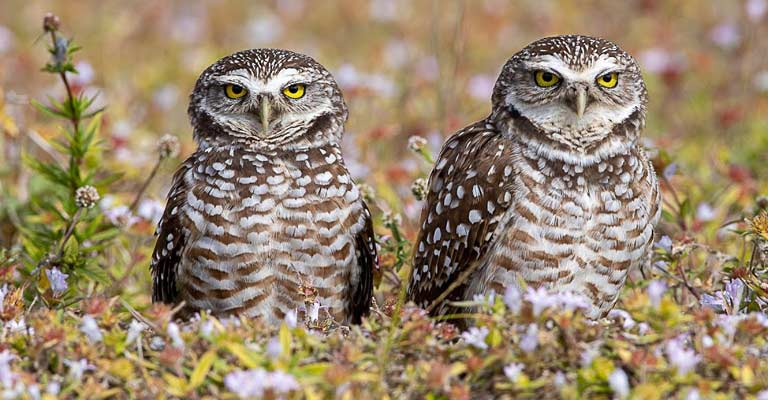
The Burrowing Owl (Athene cunicularia) is not only recognized for its distinctive appearance but also for its intriguing behavioral traits that set it apart from other owl species.
These small, ground-dwelling birds exhibit a range of behaviors that reflect their adaptability to diverse environments.
Nocturnal and Diurnal Activity
Unlike many other owl species that are strictly nocturnal, Burrowing Owls display a unique combination of nocturnal and diurnal activity.
While they are primarily crepuscular, being most active during dawn and dusk, they are frequently observed foraging and engaging in various activities during daylight hours.
This behavior is attributed to their terrestrial lifestyle and reliance on both daytime and nighttime resources.
Terrestrial Locomotion
Burrowing Owls exhibit remarkable terrestrial locomotion, utilizing their long legs for walking and running on the ground. This behavior distinguishes them from other owl species adapted to perching or gliding.
Their ability to navigate the landscape on foot is particularly evident during hunting, as they chase down prey with agility.
Head Bobbing and Tilting
During various social interactions and courtship displays, Burrowing Owls engage in distinctive head bobbing and tilting movements.
This behavior is not only charming but also serves as a form of communication between individuals.
The rhythmic movements convey information about their intentions, contributing to the complex social dynamics within their colonies.
Burrow Occupancy
As their name suggests, Burrowing Owls are skilled burrow occupants. They repurpose abandoned burrows dug by mammals like prairie dogs or ground squirrels for nesting and shelter.
Their adeptness at utilizing existing burrows showcases their resourcefulness in finding suitable habitats for breeding and raising their young.
Vocalizations
Burrowing Owls are known for their diverse vocal repertoire, consisting of various coos, chattering sounds, and high-pitched hoots.
These vocalizations serve multiple purposes, including communication within mated pairs, signaling alarm, and establishing territory boundaries.
Community Living
Burrowing Owls often exhibit a communal living style, forming loose colonies where multiple pairs nest nearby.
This behavior enhances their protection against predators and fosters social interactions within the community.
Individuals within these colonies engage in cooperative behaviors, such as group defense against potential threats.
The behavioral repertoire of Burrowing Owls is as captivating as their physical characteristics.
Their combination of diurnal and nocturnal activity, terrestrial locomotion, unique head movements, and communal living all contribute to the adaptability and ecological success of these intriguing birds.
Wrapping Up
The Burrowing Owl stands out not only for its captivating appearance but also for its fascinating behaviors.
From the distinctive head bobbing to the unique combination of diurnal and nocturnal activity, these ground-dwelling owls showcase adaptability, resilience, and intricate social dynamics.
Their terrestrial lifestyle, communal living, and utilization of abandoned burrows further contribute to their ecological success.
Understanding the behavioral nuances of the Burrowing Owl adds depth to the appreciation of this remarkable bird species and highlights the importance of conservation efforts to ensure its continued thriving in diverse environments. Thank you so much.